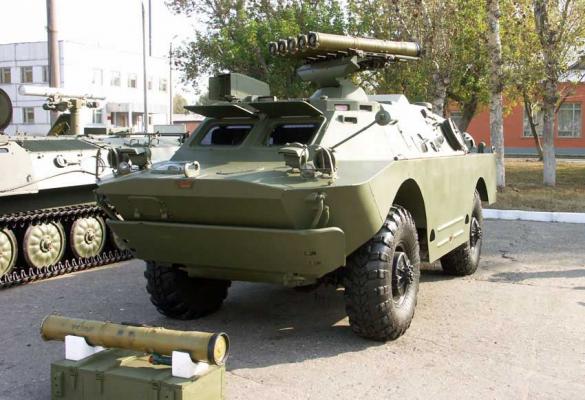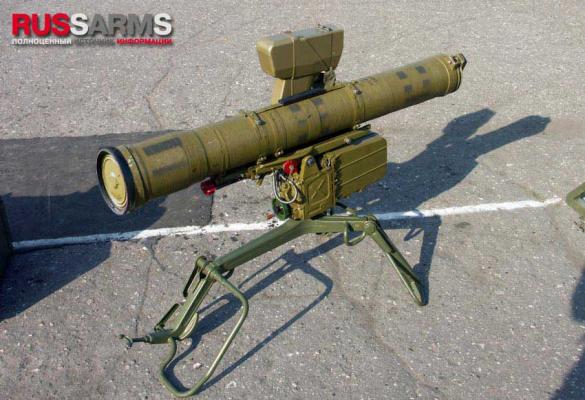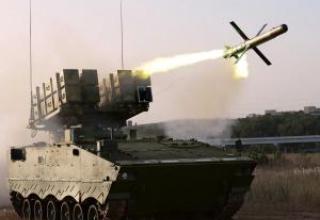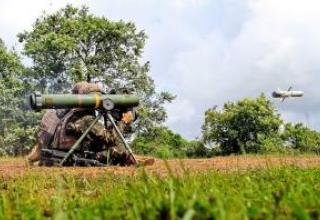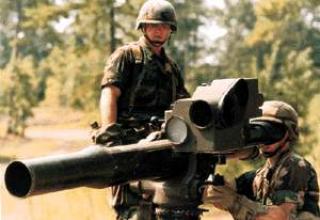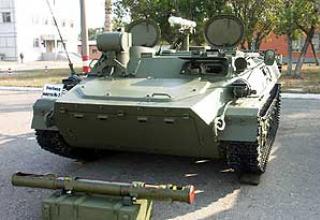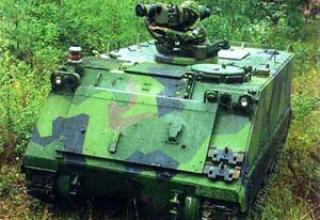The 9K113 Konkurs self-propelled anti-tank system is designed to defeat modern armored targets at a distance of up to 4 km. It forms the basis of anti-tank means of regimental level and is used in cooperation with portable complexes of battalion anti-tank units.
The Konkurs system was developed by the Instrument-Making Design Bureau (Tula) in accordance with Decree of the USSR Council of Ministers No. 30 of February 4, 1970. The new PTURS, originally named "Goboy", was later renamed "Tender". The design solutions underlying the complex mainly corresponded to those developed in the Fagot system, with significantly larger mass and dimensional characteristics of the missile, due to the need to provide greater launch range and armor penetration.
The "Contest" complex was adopted by the Soviet Army in January 1974. The Fagot system was used in motorized rifle battalions, and the Konkurs system with the 9P148 fighting vehicle was used in motorized rifle regiments and divisions. Later on it was used as a basis for development of Konkurs ATGW.
Besides Russia, the system of different modifications is in service with the land forces of Afghanistan, Bulgaria, Hungary, India, Jordan, Iran, North Korea, Kuwait, Libya, Nicaragua, Peru, Poland, Romania, Syria, Vietnam, and Finland. Own serial production of the 9M113 Konkurs anti-tank missile was deployed in Iran. The license to manufacture the missile was sold to Iran in the mid 90s.
Its western designation is AT-5 Spandrel.
Composition:
PTURS 9M113 (see layout diagram) is arranged according to the aerodynamic scheme "duck". In order to stabilize the missile's trajectory, it rotates in flight. PTURS rotation in flight is provided by blades and nozzles installed at angles of 2° and 9° respectively to the longitudinal axis of the missile. Control system - semi-automatic with transfer of commands on wires. The principle of semi-automatic control is that the operator from the moment the missile leaves the container until the target is hit, holds the crosshairs of the optical sighting grid on the target, and the projectile is automatically held on the sighting line. The location of the projectile is determined by the infrared radiation of the headlamp.
The on-board control equipment consists of a reel, a wireline, a control unit, a coordinator, a steering unit and a headlamp. All equipment is located in the equipment compartment, except for the steering unit located in the head end of the projectile. The 9B61 coordinator is a three-degree gyroscope, which aligns the control commands generated by the ground control equipment in the launch unit's coordinate system with the rotating projectile's coordinate system. The steering unit is designed to control the projectile in flight on course and pitch using aerodynamic rudders. It is an electromagnetic mechanism with pivoting anchors on which the aerodynamic rudders are mounted. The headlamp is an electrical source of infrared light radiation and is designed to determine the position of the projectile relative to the line of sight. It is located in the equipment compartment in the frame of the wire line of communication coil. PTUR 9M113 has a cumulative combat unit 9H131, which is made in the form of a combat compartment located between the steering unit and the acceleration and marching propulsion system, and consists of a housing, a cumulative charge and a safety detonating mechanism.
For PTUR "Contest" on the basis of BRDM-2 there was created combat vehicle 9P148 (see the scheme), with the lifted launcher for five missiles 9M113 placed on it in transport and launch containers (see photo1, photo2, photo3). The portable ammunition is 20 9M113 or 9M111 rounds. The guided missile package (see Photo1, Photo2, Photo3, Photo4, Photo5) can be recharged with a two-person ammo with no exit due to armour (as opposed to all systems previously accepted in the Soviet Army). Loading of the vehicle with the full set of 9M113 missiles lasts 15 minutes. After launching, the firing container is automatically reset.
When firing from the 9P148 combat vehicle, the operator presses the START button on the remote control, and 12V DC voltage is supplied from the power supply unit of the 9P148 machine control equipment to the on-board power supply, the second ground battery of the power supply unit and the coordinator's rotor powder charge. When firing from the 9P135 launcher, the operator presses the trigger of the starter mechanism located in the launcher, and voltage pulses are induced in the starter mechanism, which are fed to the electric igniters of the on-board power supply unit, the second ground battery of the power supply unit and powder charge of the coordinator rotor.
Further interaction of the projectile elements during the launch and in flight when firing from the 9P148 combat vehicle and the 9P135M launcher is similar. After 0.2 seconds, the front cover of the container is opened, and then the electric ignition of the bouncer propulsion system is triggered. The flame force ignites the 9X180 powder charge and the projectile is ejected from the container at muzzle velocity of at least 64 m/s under gas pressure. At a distance of 10-15 m from the muzzle cut of the container, the projectile launches the acceleration and marching machine. This unit is equipped with a single-chamber double-mode solid fuel jet engine. Dual mode is achieved due to the geometric shape of the gunpowder charge 9X179. After the projectile departs from the container, the light radiation of the headlamp falls into the entrance pupil of the optical-mechanical coordinator of the ground control equipment, where it is converted into an electrical signal and in the form of frequency-modulated voltage enters the equipment unit. The equipment unit automatically generates control voltages at the rate and pitch, proportional to the magnitude of linear deviation of the projectile from the line of sight. In addition to the semi-automatic control system, a manual correction mode has been introduced at the end of the trajectory to improve the accuracy of firing under conditions of optical interference and to disrupt the automatic tracking of the missile through the headlamp. The presence of interferences is signaled by a special indicator. The minimum firing range of the 9M113 shell is determined by the fuse range (about 75 m).
The vehicle is equipped with a 9P135 type remote launch vehicle, which, together with the ammunition, can be taken out of the combat vehicle and used independently of it. The sight and ground control equipment are unified for use in portable and remote versions. All means of the "Competitive" complex provide application of 9M111 missiles of the "Fagot" complex as well.
Remote control unit 9P135 of the "Competition" complex consists of:
- launcher 9П56М
- 9P155 trigger
- equipment unit 9C474
- the 9Sh119M1 missile guidance device.
The design of the 9P148 war machine's pointing drives makes it possible to fire low-flying low-speed planes and helicopters, as well as to shoot afloat at targets on the shore while forcing water obstacles. The horizontal pointing angle is 20°. Speed of fire at a maximum range of 2-3 lb./min. The calculation of the fighting vehicle 2 people. The weight of the combat vehicle is 7000 ±210 kg. The complex is adapted for landing on parachute landing platforms.
The "Contest" type missiles were used in the armament of the BMP-1P and BMP-2 infantry fighting vehicles, with four missiles. On the lighter BMD-2 and BMD-3 it was envisaged a mixed set of one "Competition" and two "Fagot" missiles.
Characteristics:
| Range of fire, m - minimum - maximum day - maximum night |
75 4,000 3,500 |
| Average flight speed at maximum range, m/s | 208 |
| Maximum rocket speed, m/sec | 250 |
| Overall dimensions,mm - container length - flare length - rocket gauge - wingspan |
1,260 1,165 135 468 |
| Weight, kg - portable controller - 9M113 rockets - missiles in the TIC |
22 14.58 25.16 |
| Fighting unit - type - weight,kg - armour permeability (60°), mm - armour permeability (at an angle of 90°), mm |
cumulative 2.75 250 600 |
| Speed of target, km/h | up to 60 |
Testing:
The first combat use of the S-200 SAM system took place in 1982 in Syria, where at a distance of 190 km the E-2C "Hawkeye" DRLO was shot down, after which the American aircraft carrier fleet withdrew from the Lebanese coast. The Libyan S-200 complexes took part in repulsing an attack by American FB-111 bombers and possibly shot down one bomber.
On the basis of the 5B28 anti-aircraft missile of the S-200B complex a hypersonic flying laboratory "Cold" has been created to test hypersonic direct-flow air jet engines. The choice of this missile was based on the fact that the parameters of its flight path were close to those required for flight tests of the Hyper-Sonic Propulsion System. It was also considered important that the missile had been decommissioned and its cost was low. The missile's combat unit was replaced by the head compartments of the GLL "Kholod", which housed the flight control system, a liquid hydrogen tank with displacement system, a hydrogen flow control system with measuring devices and, finally, the experimental HPVRD E-57 of axially symmetric configuration.
Sources:
- Р.Д.Ангельский "Отечественные противотанковые комплексы" -М: ООО "Издательство Астрель", 2002,-192с.
- Энциклопедия «Отечественного ракетного оружия». А.Б. Широкорад под общей редакцией А.Е. Тараса - М.:АСТ, Мн.: Харвест, 2003.
- Русское вооружение
- Конструкторское бюро приборостроения
